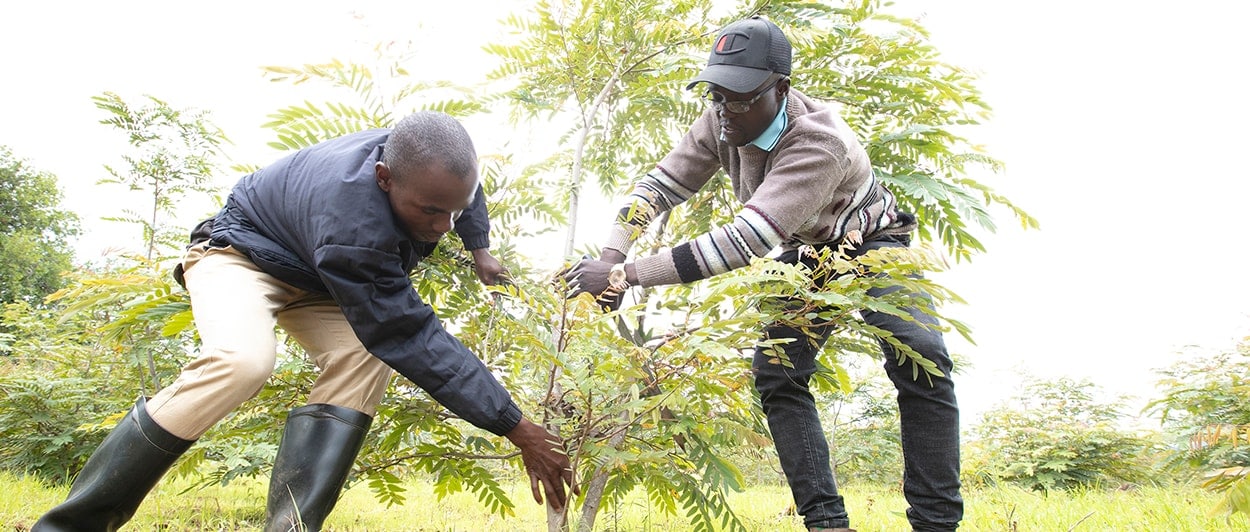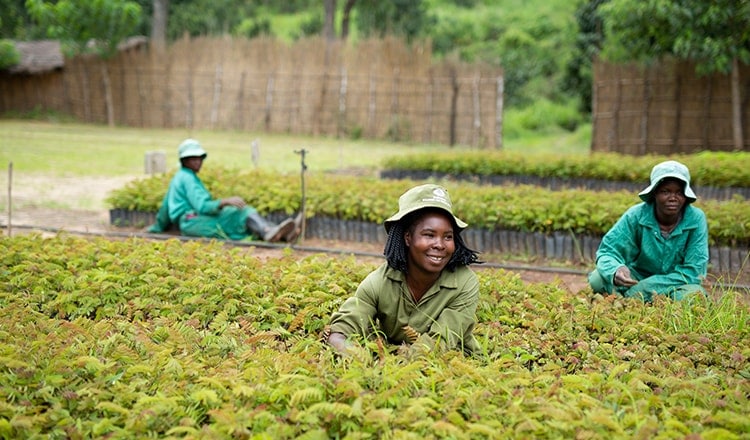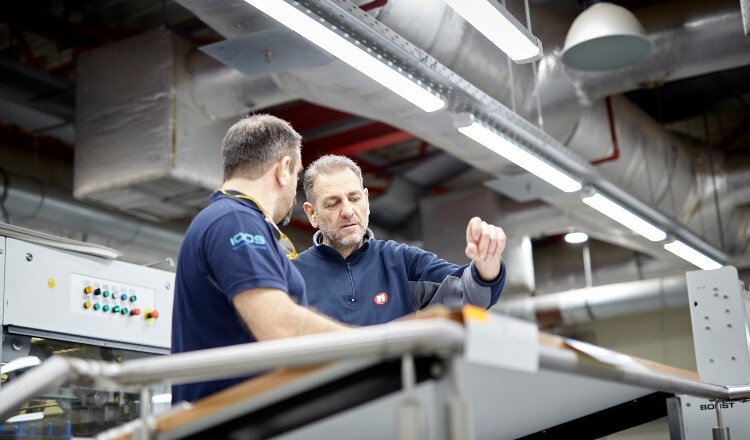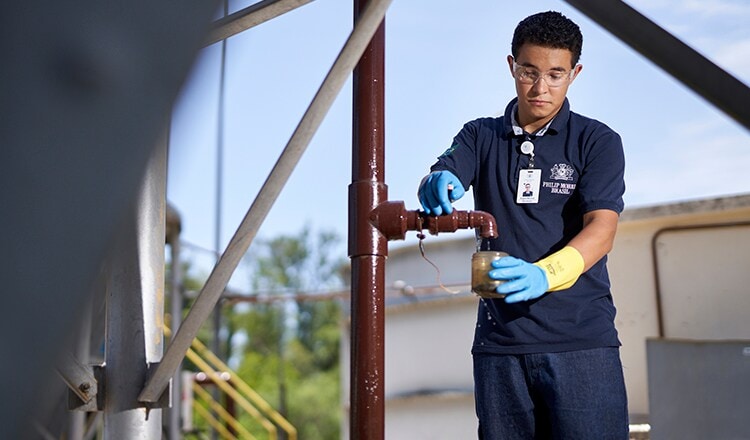| INTEGRATED REPORT 2019 |
The production of agricultural commodities is responsible for around 80 percent of deforestation worldwide.1 Forests are rich in biodiversity, and they provide diverse ecosystem services such as watershed protection, wildlife habitats, livelihoods for communities, and climate regulation. Moreover, forests store carbon, so their conversion to other land uses releases greenhouse gas emissions. Together, agriculture, forestry, and land use account for about 24 percent of global GHG emissions. Despite international initiatives, an average of 13 million hectares of forest are lost each year.2
Why it is important to us and our stakeholders
Forests are critical to regulating climatic conditions and maintaining rainfall patterns. They absorb carbon dioxide and provide the right conditions to preserve biodiversity. And, when they remain intact, forests contribute substantial economic value and resilience. Tobacco farmers, for instance, rely on forests as an important element in the water cycle and for soil protection.
Protecting forests is relevant to PMI: Wood fiber resources are used to a significant degree in our products and packaging, and firewood is also used for tobacco curing. We want to ensure that our business does not contribute to deforestation. While there are risks to forests from land-use conversion within our highly complex and extensive supply chain, our analysis shows that PMI’s contribution to this specific deforestation risk is not significant. Land used for tobacco growing is decreasing year-on-year, and with regard to packaging materials, PMI can leverage its scale to influence suppliers to source wood fiber sustainably.
Managing natural capital correctly will benefit the business over the long term. Upstream in our supply chain, for example, our business relies on natural capital from forests, water, and healthy soil. Mismanagement or depletion of these capitals – through poor forest stewardship, for instance – could affect these reserves. Just as social value can be eroded by poor forest management, it is created through the maintenance of intact or well-managed forests.
Achieving our aims
We are committed to sourcing wood-based materials from fully traceable and sustainable sources while protecting the rights and livelihoods of local communities. Our Zero Deforestation Manifesto further formalizes our commitment to work with suppliers of tobacco and paper and pulp-based products toward sustainable, traceable, and third party-verified sourcing.
To accelerate our progress against our targets, we conduct annual global deforestation risk assessments to prioritize and adjust actions. On the ground, we rely on field technicians to communicate our management approach to farmers.
Our aims:
Our targets for our tobacco supply chain:
Zero
deforestation of primary and high conservation value (HCV)3 forests associated with the tobacco supply chain by 2020
Zero net
deforestation of natural forests4 in the tobacco supply chain by 2025
Net positive
impact on forests associated with the tobacco supply chain by 2025
To protect forests in our tobacco supply chain, we also rely on our Good Agricultural Practices (GAP) program, which was established in 2002 and has been periodically updated since. It sets out plans to source sustainable wood fuel for producing flue-cured Virginia tobacco. The plans help farmers avoid contributing to the deforestation of old-growth forest (primary forest and high conservation value forest) by being self-sufficient or using a sustainable alternative source. PMI’s Monitoring and Verification Framework for Sustainable Curing Fuels is currently being applied within all of the company’s flue-cured tobacco supply chain. For the Burley type of tobacco, the risk of deforestation relates to the wood used to build curing barns for its air-curing. This risk is present mainly in Malawi and Mozambique. Engagement with suppliers and farmers is again crucial, and, under the GAP program, we aim to improve the lifespan of all types of barns and switch them to sustainable sources of timber.
Regeneration of ecosystems is important when facing the risk of deforestation, so we are working with tobacco suppliers and farmers to restore forests, going beyond the sustainable sourcing of wood fuel to deliver a net positive impact by 2025. We will do this by restoring hundreds of hectares of forest to enhance biodiversity and natural habitats.
To protect forests in our paper and pulp-based product supply chains, we base our due diligence on PMI’s Responsible Sourcing Principles (RSP), using a bespoke supplier platform. The RSP have been communicated to all our global and regional suppliers of paper and pulp. The platform allows us to engage further with and assess suppliers, obtain primary data, and complete the PMI Deforestation Risk Assessment.
Our targets relating to paper and pulp-based products:
Zero
deforestation of primary and HCV forests associated with the supply chain of paper and board by 2022
Zero
deforestation of primary and HCV forests associated with the supply chain of other significant pulp-based products, including cellulose acetate tow, by 2025
Zero net
deforestation of natural forests in paper and pulp-based products supply chains by 2030
Progress in 2019
Monitoring the risks
The risk of PMI causing deforestation is low overall. Our 2019 risk assessment indicates where there is an elevated risk to old-growth forests or their equivalent. It includes some of the countries from which we source Virginia flue-cured tobacco. All countries assessed include regions with some level of risk, but deforestation may not be caused by PMI’s tobacco and pulp-based materials suppliers. We conducted two detailed country-level assessments in 2019 to establish greater detail of risk and impact.
Deforestation risk takes many forms, but the common approach to risk mitigation is supplier engagement. Knowing where wood and wood-based materials come from is vital to understanding the risk and to engaging with suppliers on targeted areas for improvement. While it helps to manage the risk, complete traceability is not always possible. For example, most of our larger suppliers have established forest protection measures, while others, usually smaller suppliers, may be more limited. Once we start working with a supplier, we often can help improve their forest risk mitigation.
PMI’s Zero Deforestation Manifesto commits us to halting deforestation within our supply chain and its impacts. The high standards required of our supply chain, especially in terms of traceable and sustainable tobacco curing fuels, may cause indirect deforestation outside the forested areas that are within the sphere of influence of our suppliers and farmers. We take this risk seriously and are analyzing its extent as we implement protection practices in primary forests.
Forest protection in our tobacco supply chain
Equipped with the outcomes of our risk assessments, we are moving closer to delivering on our goal of being forest positive by 2025. We are increasing the use of traceable, sustainably sourced curing fuels and are promoting the planting of “live barns” in Malawi and Mozambique.
In 2019, the proportion of tobacco we purchased that was cured with no risk of deforestation stood at 97 percent (2018: 90 percent). This demonstrates clear progress toward our target of zero deforestation of primary and HCV forest associated with our tobacco supply chain by 2020.
Sustainable curing fuel in tobacco production
The curing process for Virginia tobacco takes place in barns that are heated using a variety of fuel sources, including firewood. To mitigate the risk of firewood being from deforestation and to contribute to our zero deforestation goals, we are increasing the efficiency of curing barns that use firewood in the process and estimating how much forest is protected as a result. This can be achieved by reducing fuel use in the curing cycles of conventional barns, as in Malawi, or by switching gradually to bulk barns, as in Brazil. An additional business benefit is improved tobacco quality as a result of better curing.
Across our global tobacco supply chain, the average amount of wood used for curing decreased from 5.69 kilograms to 3.99 kilograms of wood per kilogram of cured tobacco between 2015 and 2019, a reduction of 30 percent.
In the Philippines, for example, just over a third of farmers in our supply chain collect firewood themselves, with the remainder purchasing it. To move to zero deforestation of primary and HCV forest by 2020, we are engaging with our suppliers and their contracted farmers to ensure firewood purchased is guaranteed to be not from old-growth forests (OGF). Intensified monitoring will focus on the dense forest areas in the Abra region and ensure there is no OGF loss in the more susceptible “open” forests near tobacco farms. You can read more in our case study: PMFTC: A sustainable footprint.
In Malawi, the risk of OGF deforestation is minimal and typically relates to informal firewood purchases. Both our suppliers in this market draw from existing tree plantations to provide nearly all the firewood needed by smaller farmers for tobacco curing. In 2019, 92 percent of the tobacco purchased by PMI in Malawi was cured with sustainable firewood provided by the suppliers; in 2020, we target to increase this to 100 percent. We are working with a local supplier to collect proof that firewood purchased from informal vendors is from sustainably managed secondary forest.
In Brazil, we are working with suppliers to switch to bulk barns for curing, which are more efficient and require less firewood. In addition, we are increasingly using alternative biomass fuels. In the Cerrado region, for example, the curing barns are heated using wood chips from sustainably managed sources.
Curing barn construction
The Burley variety of tobacco we purchase from Malawi and Mozambique, among other countries, is air-cured. The construction and maintenance of the curing barns depend on timber, which needs to be replaced regularly. As highlighted in our annual deforestation risk assessment, this places forests at risk. To avoid this, as reported in our 2018 Sustainability report, we promote the use of “live barns,” which use living trees as curing poles and remain in place for many years.
During the 2019 crop year, we worked with our suppliers to plant 69,124 live barns in Mozambique. Since 2014, a total of 255,062 live barns have been planted, out of which 11,284 have now reached a size that allows them to be used for curing.
Meanwhile in Malawi, 19,789 live barns have been planted, making a cumulative total of 91,478 since 2014, 804 of which are already in use.
From seedlings to live barns, PMI suppliers and farmers are working to ensure high rates of tree survival and growth. Our success depends on ongoing engagement with suppliers and farmers, brought to life through the on-the-ground facilitation of field technicians working with contracted farms.
Land-use change
Our 2018 global deforestation risk assessment determined that risks associated with land-use change resulting from tobacco farming are not significant. The risk continues to be low: More productive tobacco seed varieties and other good agricultural practices implemented in line with PMI’s GAP principles and standards help to maximize yield per hectare, improve farmer income, and thus reduce pressure to expand crops into forests. Our analysis shows that there is no direct deforestation risk associated with our tobacco sourcing due to the global contraction of the amount of land needed to fulfill our crop requirements. A 2019 land-use-change study by Quantis confirmed this.
Traceability and verification in our tobacco supply chain
Knowing from where materials come is crucial to understanding and managing supply chain risk, but complete traceability is not always possible. We are working to maximize traceability up the supply chain for high-risk materials, including tobacco leaf.
We use our Monitoring and Verification Framework for Sustainable Curing Fuel to systematically monitor the sustainability of all fuel types used in our tobacco supply chain. For firewood and other biomass fuel, we apply a risk mitigation plan aligned to the way it is sourced. Firewood may be obtained from a government concession, firewood vendors, or farmer-owned woodlots. The framework provides an internal standard aligned with international best practices and is verified by a third party. It requires a full chain of custody not only for tier 1 suppliers (those that supply PMI directly) but also for tier 2 suppliers (firewood and other biomass providers).
Also, we use agriculture-derived fuel sources where they do not compete with food production or negatively affect food security. This, along with clear goals and active engagement with suppliers and their farmers, has helped us to achieve greater traceability. The proportion of tobacco leaf purchased in 2019 that was cured using renewable and traceable fuels stands at 51 percent (2018: 46 percent).
Reforestation
By 2025, we aim to enhance capital stocks of biodiversity and natural habitats by restoring hundreds of hectares of forest land. Reforestation complements initiatives to protect forests through our sustainable-fuel initiatives.
We require our suppliers and farmers to be self-sufficient in wood for curing and construction. By 2025, we want them to grow more trees than they cut. We will also work with them on forest-land restoration, biodiversity, and natural habitats, focusing on ecologically valuable and sensitive land such as HCV areas.
Tree planting requires careful management and is only done on marginal lands where the carbon stock and existing biodiversity assets, including the soil, can be enhanced. Since 2000, we have supported our contracted farmers and suppliers in planting more than 263 million trees of different species. Fast-growing trees provide farmers with firewood, while others yield medicinal ingredients and fruit. Slower-growing species provide farmers with high-value hardwoods for additional income.
Deforestation risks in pulp, paper, and other supply chains
We have assessed PMI’s exposure to deforestation risk in our other supply chains and have deepened our assessment of individual suppliers. This allows us to refine our approach on biomass sourcing, raw materials traceability, certification and verification, and use of recycled materials. We are investing in extensive supplier engagement- and capacity-building activities, which will be key to successfully deploying our strategies.
By the close of 2022, we aim for zero deforestation of primary and HCV forests associated with PMI’s supply chain for paper and board used in our packaging. In 2019, we held several webinars to present our Zero Deforestation Manifesto, with participation from all our relevant suppliers for paper and board-based materials. In addition, we held a number of benchmark and exchange meetings with selected key suppliers, industry experts, and companies with the objective to share and learn about best practices. We gained valuable insights through these activities, which we are incorporating in the supplier assessment we are finalizing.
Further, by the close of 2025, we aim for zero deforestation of primary and HCV forests associated with our supply chain for paper and board used in our products, including cellulose acetate tow.
By 2030, we aim to achieve zero net deforestation of natural forests in our paper and pulp-based products supply chains.
Our Responsible Sourcing Principles have been communicated to all paper and pulp-based materials suppliers. Our STEP supplier due diligence platform is currently onboarding significant suppliers of paper and pulp-based materials. Through our risk-based approach, we are making progress toward 100 percent transparency on supplier practices.
Where the management of deforestation risk is found to be slower than expected, we expand and intensify our engagement process. In 2019, as part of our due diligence, we conducted specialized audits, in partnership with specialist NGOs, to go into greater depth with one of PMI’s significant suppliers. These audits have allowed us to explore specific impacts such as chain of custody and land rights in their operations and to set up mitigation plans.
Further, we are setting longer-term engagement and collaboration programs with suppliers of all key raw materials, such as board, paper, and acetate tow.

Next steps
Our goal is to deepen our understanding of supplier practices and deforestation risk across our whole supply chain. We will continue to roll out our monitoring framework in our tobacco supply chain and to develop risk mitigation actions with specific suppliers in other supply chains, with the aim of increasing traceability and the share of materials in compliance with our Zero Deforestation Manifesto. We will be reporting on progress against our 2022 deforestation target related to paper and board used in our packaging.
We will continue to update and adjust our management of deforestation risks based on the results of our regular global risk assessments. We will continue to assess tobacco as well as paper and pulp-based materials, with a specific focus on high-risk countries.
We recognize the emergence of a landscape-level approach to restoration, including how engagement and metrics account for the more holistic approach to sustainable resource management.
We will continue to focus on forest restoration, with a view to measuring specific surface areas converted by 2025.
1 UN SDG, SDG 15 Life on Land, 2019.
2 FAO, 2010, Global Forest Resources Assessment 2010, Rome.
3 High conservation value refers to biological, ecological, social, or cultural values that are outstandingly significant or critically important at the national, regional, or global level. The HCV approach is the three-step process in which HCVs are identified, managed, and monitored. We incorrectly referred to “zero net deforestation” ambitions with regard to primary and HCV forests in our Sustainability Report 2018; due to the nature of these targets, we revised them in 2019 to appropriately refer to “zero deforestation.”
4 Natural forests are areas with tree cover that are not classified as plantations, in which all or almost all trees and other plants are indigenous species, and in which many of the principal characteristics and key elements of native ecosystems, such as complexity, structure, and diversity, are present. They include primary and secondary forests, old-growth forests, degraded forests, and naturally regenerated forests.
This online supplement to our integrated report should be read in conjunction with PMI’s Integrated Report 2019. The information and data presented in this online supplement cover the 2019 calendar year or reflect status at December 31, 2019, worldwide, unless otherwise indicated. Where not specified, data come from PMI estimates. See About this online supplement for more information. Aspirational targets and goals do not constitute financial projections, and achievement of future results is subject to risks, uncertainties and inaccurate assumptions, as outlined in our forward-looking and cautionary statements.





